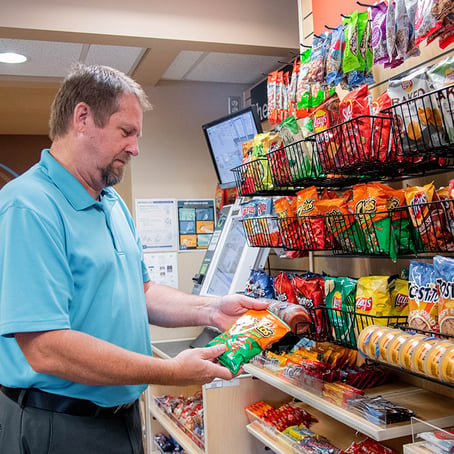Anyone in business (or life in general) can say they’re inundated with hundreds of decisions every single day. How to increase employee retention. How to approach marketing and brand initiatives, where to focus to generate new revenue streams, what tasks to delegate and which tasks to handle individually, and what to eat for lunch.
The list of decisions just gets longer and longer each day. At work especially, decision-making is often a step-by-step process that involves other people, research, strategy, and implementation. Sound familiar? If that’s how it looks where you are and you’re considering how to implement a micro market vending solution in your office, building, or campus, here are the steps you can take to make it happen.
The steps to follow to implement a micro market within your business might be easier than anything else you’ll do today. Here’s where to start:
Determine what you are currently offering the people connected to your building or site. Do you have a current vending model in place? Is it outdated or simply not enough anymore for your growing team? Understanding what’s in place and how it can be improved or expanded is a necessary first step in implementing a micro market. Next, consider options and customization needs. Ask your tenants, employees, or guests about their thoughts on a micro market. Is there early buy-in for its implementation — meaning, will they actually use it and look forward to its presence? What types of food and beverage do people want? Ask the right questions and generate excitement and hype. Finally, consider the key to any successful business relationship as working with the people or brands you trust. When scouting potential micro market options, keep in mind that particular vending model comes with ongoing support and management (as it should!). There’s more to the transaction than simply choosing a company to install it, drop off inventory, and open it up for use. Look beyond the products, equipment, and tangible pieces of the micro market to customer service philosophies and business standards. Is the distributor trustworthy? Are they experts? How do they measure success? How do they handle issues or concerns?
Tips to Improve Your Micro Market Business
Running a successful micro market operation requires careful planning, effective management, and a focus on customer satisfaction. Here are some tips to improve your micro market operations and enhance your business overall:
Product Integrity
Offer a diverse selection of products to cater to different tastes and dietary preferences. Include options for healthy snacks, beverages, fresh foods, and convenience items. Ensure that your micro market is well-stocked at all times. Regularly monitor inventory levels and restock popular items to avoid empty shelves. Maintain high standards of product quality and freshness. Regularly check expiration dates and rotate stock to ensure that customers receive fresh and appealing products. Ensure that all equipment, including kiosks and coolers, is properly maintained and in good working condition. Address technical issues promptly to minimize disruptions.
Convenience is Key
Choose the right location for your micro market. Consider factors like foot traffic, accessibility, and the demographics of the target audience. Implement user-friendly self-checkout kiosks and mobile apps for easy and efficient transactions. Ensure that the technology is intuitive and provides a seamless customer experience. Clearly display pricing for all items in the micro market. Avoid hidden fees and ensure that customers can easily see the cost of each product. Provide multiple payment options, including cashless payments, credit/debit cards, and mobile wallets, to accommodate different preferences.
Feedback is King
Train your staff to assist customers, troubleshoot issues, and ensure smooth operations. Friendly and knowledgeable staff can enhance the customer experience. Use data analytics to track sales trends, popular items, and customer preferences. This information can help you make informed decisions about inventory and promotions. Conduct regular assessments of your micro market's performance. Evaluate what's working well and identify areas for improvement. Act on customer feedback and adapt your offerings based on demand and trends. This flexibility can help you stay relevant and meet customer needs. Marketing and communication is another feature to consider—promote your micro market within the hosting location. Use signage, posters, and digital displays to inform customers about your offerings and promotions.
Where Bernick's Comes In
If you choose to select Bernick's, you can start the process with a discussion and potential site visit from a Bernick's Micro Market Specialist. This step will involve conversations over the layout, size, and location within your building or campus. You’ll discuss the requirements on your behalf — location, electrical access, and internet access. After the planning is complete, you'll review the featured food and beverage offerings available, and a brief restocking plan. Take comfort in knowing your Bernick's rep will handle all those aspects ongoing ... meaning no more decisions for you — or your company's management team!



